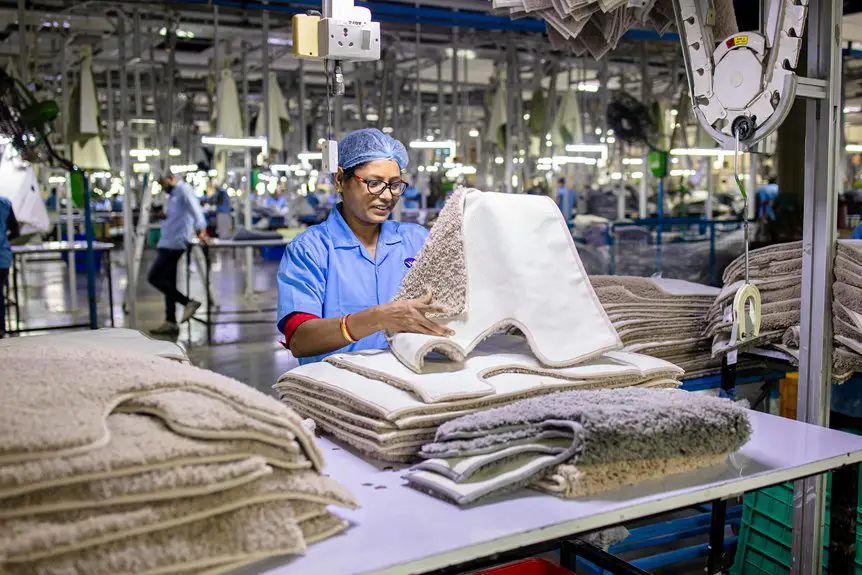When you choose a jacket made with Bluesign® certified fabric, you’re opting for a product that’s free from harmful chemicals. This certification means the brand is committed to fabric safety and minimizing its environmental impact. But what does this really entail for both the materials you wear and the planet’s health? Understanding the nuances behind Bluesign certification can help you make more informed choices in your wardrobe.
Table of Contents
Key Takeaways
- Bluesign certification ensures fabrics are free from harmful substances, promoting safety for wearers and reducing skin irritations and allergies.
- The certification supports sustainable practices, minimizing waste and energy consumption throughout the fabric production process.
- Brands with Bluesign certification demonstrate commitment to ethical labor conditions and transparency within their supply chains.
- Consumers can trust Bluesign-certified products, knowing they meet strict safety and environmental criteria, enhancing their informed purchasing decisions.
- Embracing Bluesign certification helps brands differentiate themselves, build consumer trust, and position themselves as leaders in sustainability.
Understanding Bluesign Certification
When you choose fabrics with Bluesign® certification, you’re opting for a commitment to safety and sustainability. This certification means that the fabric meets strict environmental and safety criteria throughout its production process. It guarantees that harmful substances are eliminated, protecting both workers and the environment.
You’ll find that Bluesign® certified fabrics use resources more efficiently, reducing water and energy consumption.
Additionally, the certification promotes responsible chemical management, guaranteeing that any chemicals used are safe for you and the planet.
By selecting these fabrics, you’re supporting transparent supply chains and encouraging brands to prioritize ethical practices.
It’s not just about the fabric; it’s about making a conscious choice that aligns with your values towards a healthier and more sustainable future.
The Importance of Fabric Safety Standards
Fabric safety standards are essential for ensuring that the materials you wear are free from harmful chemicals and produced in a safe environment.
When you prioritize these standards, you’re making choices that benefit not just yourself but also those around you.
Here are four reasons why fabric safety matters:
- Health Protection: Wearing safe fabrics reduces the risk of skin irritations and allergies.
- Environmental Responsibility: Standards help limit toxic waste and promote cleaner production methods.
- Consumer Confidence: Knowing your clothes meet safety standards gives you peace of mind.
- Social Accountability: Supporting safe practices encourages ethical labor conditions and fair treatment of workers.
Eco-Impact Reduction Through Sustainable Practices
As you explore sustainable practices, you’ll discover that reducing eco-impact is essential for a healthier planet. By adopting eco-friendly methods, you can greatly lower your carbon footprint and conserve resources. For example, using organic materials, minimizing waste, and implementing energy-efficient processes can lead to substantial environmental benefits.
Here’s a quick overview of key practices:
| Practice | Eco-Impact Reduction | Benefits |
|---|---|---|
| Organic Materials | Reduces chemical use | Healthier ecosystems |
| Waste Minimization | Lowers landfill waste | Cost savings |
| Energy Efficiency | Decreases energy consumption | Reduced greenhouse gases |
Embracing these sustainable practices can help create a more sustainable future for everyone.
Advantages for Brands Embracing Bluesign Certification
Adopting Bluesign Certification offers brands a significant edge in the competitive marketplace.
By embracing this standard, you not only enhance your reputation but also create a more sustainable future.
Here are four compelling advantages for your brand:
- Consumer Trust: Customers increasingly seek brands that prioritize safety and sustainability, boosting loyalty.
- Market Differentiation: Stand out in a crowded industry by showcasing your commitment to eco-friendly practices.
- Regulatory Compliance: Stay ahead of regulations and avoid potential penalties by adhering to rigorous safety standards.
- Cost Efficiency: Optimize resource use and reduce waste, leading to long-term savings.
Being certified isn’t just about meeting standards; it’s about positioning your brand as a leader in sustainability.
Empowering Consumers With Informed Choices
How can you make smarter choices when purchasing clothing? By understanding Bluesign® certification, you empower yourself to select fabrics that prioritize safety and environmental responsibility.
Empower your clothing choices by understanding Bluesign® certification for safety and environmental responsibility.
When you see the Bluesign label, you know the product meets stringent criteria, ensuring harmful chemicals were minimized during production. This certification also means the fabric’s lifecycle is considered, promoting sustainability.
Take a moment to research brands committed to Bluesign standards. Ask questions about their practices and sourcing.
By choosing certified products, you support companies that prioritize eco-friendly methods and responsible manufacturing. With informed choices, you not only enhance your wardrobe but also contribute to a healthier planet.
Frequently Asked Questions
How Long Does the Bluesign Certification Process Take?
The Bluesign certification process typically takes several months. You’ll need to submit documentation and undergo thorough assessments. Once everything’s reviewed, you’ll receive feedback and, if successful, your certification will be granted.
What Costs Are Associated With Obtaining Bluesign Certification?
Obtaining Bluesign certification involves various costs, including application fees, testing expenses, and potential modifications to your production processes. You’ll also need to invest in training and compliance measures to meet the necessary standards effectively.
Are There Any Specific Materials Excluded From Bluesign Certification?
Yes, certain materials aren’t eligible for Bluesign certification. These include hazardous substances, heavy metals, and materials that don’t meet environmental standards. You’ll want to check specific guidelines to guarantee compliance with their criteria.
Can Companies Lose Their Bluesign Certification?
Yes, companies can lose their Bluesign certification if they fail to meet the required standards or violate the guidelines. Regular audits and compliance checks guarantee that companies maintain their commitment to sustainable practices and safety.
How Often Is Bluesign Certification Renewed?
You might find it interesting that the Bluesign certification is renewed annually, ensuring companies consistently meet strict standards. This frequent evaluation helps you trust the ongoing commitment to sustainability and safety in the fabrics you choose.
- Where to Buy Sherpa Suede Fabric - July 12, 2025
- How to Draw or Illustrate the Texture of Suede Fabric - July 12, 2025
- What Is Baseball Suede Leather Fabric? - July 12, 2025





